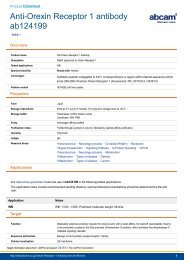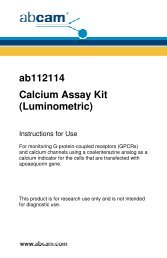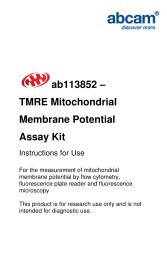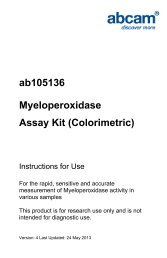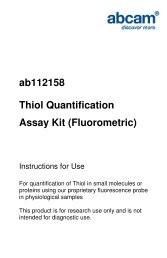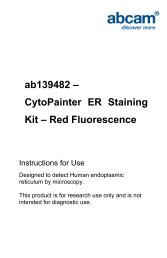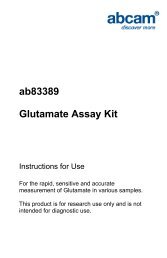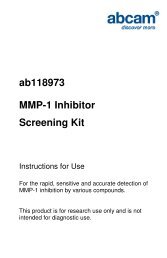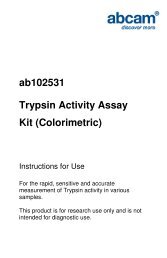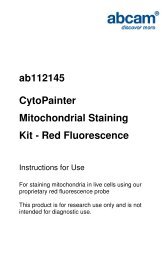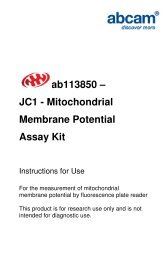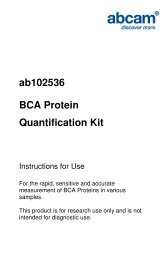TROUBLESHOOTING TIPS - ELISA - Abcam
TROUBLESHOOTING TIPS - ELISA - Abcam
TROUBLESHOOTING TIPS - ELISA - Abcam
Create successful ePaper yourself
Turn your PDF publications into a flip-book with our unique Google optimized e-Paper software.
<strong>TROUBLESHOOTING</strong> <strong>TIPS</strong> - <strong>ELISA</strong>Positive results in negative controlContamination of reagents/samplesMay be contamination of reagents or samples, or cross contamination from splashing between wells.Use fresh reagents and pipette carefully.Sandwich <strong>ELISA</strong> – Detection antibody is detecting coating antibody.Check the correct coating antibody and detection antibodies are being used and that they will not detecteach other.Insufficient washing of platesEnsure wells area washed adequately by filling the wells with wash buffer. Ensure all residual antibodysolutions are removed before washing.To much antibody used leading to non-specific bindingCheck the recommended amount of antibody suggested. Try using less antibody.High background across entire plateConjugate to strong or left on too longCheck dilution of conjugate, use it at the recommended dilution. Stop the reaction using stop buffer assoon as the plate has developed enough for absorbance readings.Substrate solution or stop solution is not freshUse fresh substrate solution. Stop solution should be clear (if it has gone yellow, this is a sign ofcontamination and it should be replaced).Reaction not stoppedColour will keep developing if the substrate reaction is not stopped.Plate left too long before reading on the plate readerColour will keep developing (though at a slower rate if stop solution has been added)Contaminants from laboratory glasswareEnsure reagents are fresh and prepared in clean glassware. Sterilise glassware beforehand ifSubstrate incubation carried out in the lightSubstrate incubation should be carried out in the dark.www.abcam.com/technical
Incubation temperature too highAntibodies will have optimum binding activity at the correct temperature. Ensure the incubations arecarried out at the correct temperature and that incubators are set at the correct temperature andworking. Incubation temperature may require some optimisation.Non-specific binding of antibody.Ensure a block step is included and a suitable blocking buffer is being used. We recommend using 5 to10% serum from the same species of the secondary antibody, or bovine serum.Ensure wells are pre-processed to prevent non specific attachmentUse an affinity purified antibody, preferably pre-absorbedAlso check suggestions listed under ‘Positive results in negative control’Low absorbance valuesTarget protein not expressed in sample used/ Low level of target protein expression in sampleusedCheck the expression profile of the target protein to ensure it will be expressed in your samples. If thereis low level of target protein expression, increase the amount of sample used, or you may need tochange to a more sensitive assay. Ensure you are using a positive control within the detection range ofthe assay.Insufficient antibodyCheck the recommended amount of antibody is being used. The concentration of antibody may requireincreasing for optimisation of resultsSubstrate solutions not fresh or combined incorrectlyPrepare the substrate solutions immediately before use. Ensure the stock solutions are in date andhave been stored correctly, and are being used at the correct concentration. Ensure the reagents areused as directed at the correct concentration.Reagents not fresh or not at the correct pHEnsure reagents have been prepared correctly and are in dateIncubation time not long enoughEnsure you are incubating the antibody for the recommended amount of time, if an incubation time issuggested. The incubation time may require increasing for optimisation of results.Incubation temperature too lowAntibodies will have optimum binding activity at the correct temperature. Ensure the incubations arecarried out at the correct temperature and that incubators are set at the correct temperature andworking. Incubation temperature may require some optimisation.www.abcam.com/technical
Ensure all reagents are at room temperature before proceeding.Stop solution not addedAddition of stop solution increases the intensity of colour reaction and stabilizes the final colour reactionHigh absorbance values for samples and/or positive control - absorbance doesnot go down as the sample is diluted down the plate).The concentration of samples or positive control is too high and out of range for the sensitivity of theassay. Re-assess the assay you are using OR reduce the concentration of samples and control bydilution before adding to the plate. Take the dilution into account when calculating the resultingconcentrations.Inconsistent absorbances across the platePlates stacked during incubationsStacking of plates does not allow even distribution of temperature across the wells of the plates. Avoidstacking.Pipetting inconsistentEnsure pipettes are working correctly and are calibrated. Ensure pipette tips are pushed on far enoughto create a good seal. Take particular care when diluting down the plate and watch to make sure thepipette tips are all picking up and releasing the correct amount of liquid.This will greatly affect consistency of results between duplicates.Antibody dilutions/Reagents not well mixedTo ensure a consistent concentration across all wells, ensure all reagents and samples are mixedbefore pipetting onto the plate.Wells allowed to dry outEnsure lids are left on the plates at all times when incubating. Place a humidifying water tray (bottledclean/sterile water) in the bottom of the incubator.Inadequate washingThis will lead to some wells not being washed as well as others, leaving different amounts of unboundantibody behind which will give inconsistent results.Bottom of the plate is dirty affecting absorbance readings.Clean the bottom of the plate carefully before re-reading the plateColour developing slowlyPlates are not at the correct temperaturewww.abcam.com/technical
Ensure plates are at room temperature and that the reagents are at room temperature before useConjugate too weakPrepare the substrate solutions immediately before use. Ensure the stock solutions are in date andhave been stored correctly, and are being used at the correct concentration. Ensure the reagents areused as directed, at the correct concentration.Contamination of solutionsPresence of contaminants, such as sodium azide and peroxidise can affect the substrate reaction.Avoid using reagents containing these preservatives.www.abcam.com/technical



